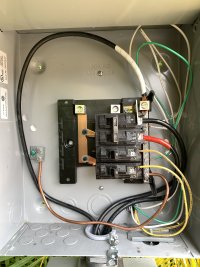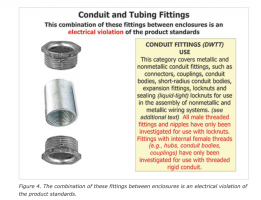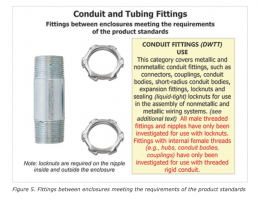jar546
CBO
I learned something today, very helpful for those of you that do inspections of PV systems and for general knowledge of the rest.
Except for a certain type of PV system, all backfed breakers are required to have a hold down or tie down. here is an example:

The top right double pole breaker is backfed from the service and supplies power to the panel bus. In this situation they used a metal tie down which connects to the breaker and ties it to the panel so that you can't flip the breaker out. This is for these cheap, snap in breakers you see in most cases. This would not apply to backfed breakers that are bolt in as seen in bigger commercial or industrial applications.
If, however you are looking at a PV system as found in NEC 690 and have an "interactive" inverter or source that is listed and labeled as an interactive supply/source you are told to comply with NEC 705 at which point it tells you that you don't have to comply with 408.36(D).
Here is the flow as seen below:
690.59 Connection to Other Sources. PV systems connected
to other sources shall be installed in accordance with Parts I
and II of Article 705.
As you can see we are sent to NEC 705 for connecting the PV system to utility power.
Section 705 is for Interconnected Electric Power Production Sources
705.12 Point of Connection
705.12(B)(5) Fastening. Listed plug-in-type circuit breakers backfed
from electric power sources that are listed and identified as
interactive shall be permitted to omit the additional fastener
normally required by 408.36(D) for such applications.
This now eliminates the requirement of 408.36(D) which is one of the most common violations that I encounter.
(D) Back-Fed Devices. Plug-in-type overcurrent protection
devices or plug-in type main lug assemblies that are backfed
and used to terminate field-installed ungrounded supply
conductors shall be secured in place by an additional fastener
that requires other than a pull to release the device from the
mounting means on the panel.
So remember, it the supply source such as an inverter or combiner box that feeds AC to the service must be listed and labeled as "interactive"
For those unfamiliar with what interactive means in this applications it is essentially a device that works in conjunction with the utility service. The reason it is not required to be tied down when it backfeeds a snap in breaker is because as a safety design, if it loses contact with the service bus and does not sense house voltage it stops producing power, therefore it is just like any other breaker that pops out.
I hope this helps.
Except for a certain type of PV system, all backfed breakers are required to have a hold down or tie down. here is an example:

The top right double pole breaker is backfed from the service and supplies power to the panel bus. In this situation they used a metal tie down which connects to the breaker and ties it to the panel so that you can't flip the breaker out. This is for these cheap, snap in breakers you see in most cases. This would not apply to backfed breakers that are bolt in as seen in bigger commercial or industrial applications.
If, however you are looking at a PV system as found in NEC 690 and have an "interactive" inverter or source that is listed and labeled as an interactive supply/source you are told to comply with NEC 705 at which point it tells you that you don't have to comply with 408.36(D).
Here is the flow as seen below:
690.59 Connection to Other Sources. PV systems connected
to other sources shall be installed in accordance with Parts I
and II of Article 705.
As you can see we are sent to NEC 705 for connecting the PV system to utility power.
Section 705 is for Interconnected Electric Power Production Sources
705.12 Point of Connection
705.12(B)(5) Fastening. Listed plug-in-type circuit breakers backfed
from electric power sources that are listed and identified as
interactive shall be permitted to omit the additional fastener
normally required by 408.36(D) for such applications.
This now eliminates the requirement of 408.36(D) which is one of the most common violations that I encounter.
(D) Back-Fed Devices. Plug-in-type overcurrent protection
devices or plug-in type main lug assemblies that are backfed
and used to terminate field-installed ungrounded supply
conductors shall be secured in place by an additional fastener
that requires other than a pull to release the device from the
mounting means on the panel.
So remember, it the supply source such as an inverter or combiner box that feeds AC to the service must be listed and labeled as "interactive"
For those unfamiliar with what interactive means in this applications it is essentially a device that works in conjunction with the utility service. The reason it is not required to be tied down when it backfeeds a snap in breaker is because as a safety design, if it loses contact with the service bus and does not sense house voltage it stops producing power, therefore it is just like any other breaker that pops out.
I hope this helps.



